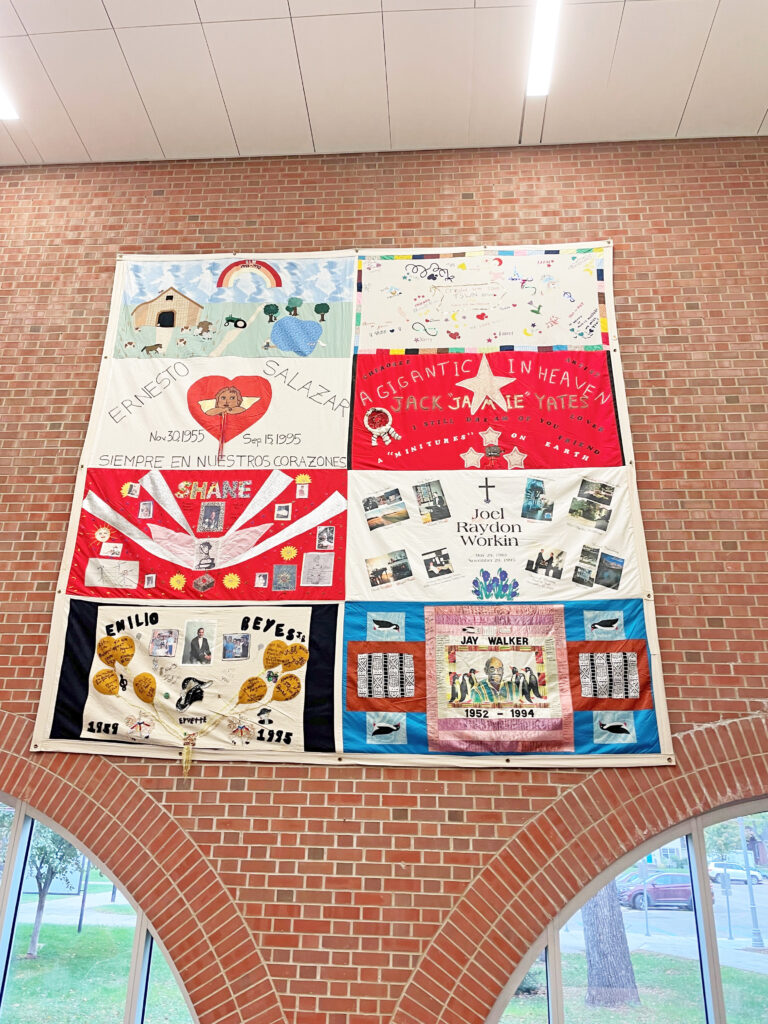clay county histories
Markus Krueger | Program Director HCSCC

A panel including Joel Workin’s quilt at MSUM.
Panels from the National AIDS Memorial Quilt are now on display at the Minnesota State University Moorhead library. MSUM, Red River Rainbow Seniors, the Quilters’ Guild of North Dakota, and the Historical and Cultural Society of Clay County are teaming up to add some local names to this unique monument made of fabric.
The AIDS Memorial Quilt is the largest ongoing community folk art project in the world. In the mid-1980s, artist and gay rights activist Cleve Jones wanted a meaningful way to remember his friends who were dying of this new disease that had no cure. “By the fall of 1985 almost everyone I knew was dead or dying,” said Jones. He came upon the idea of making each of them a quilt. Quilts are warm, comforting, and the act of making them might provide therapy for people in grief. Each person’s quilt is 3 by 6 feet – the size of a grave. Jones wanted to give people a visual representation of how many people were dying of this disease, how many graves had been dug.
Each person who has died of AIDS can have a quilt made for them by loved ones or volunteers. These 3×6 quilts are sown together in blocks 10 feet by 10 feet. There are now over 50,000 such blocks containing quilts in memory of over 105,000 people. It is too big to be shown all together, but the National AIDS Memorial sends blocks around the country for people to see. MSUM has five blocks on display, each including quilts made in memory of local people: Jimmy Brashears, Steve Cassidy, Brian Coyle, Thomas Keynton, and Joel Workin.
Red River Rainbow Seniors and the Library and Archives of MSUM have identified six local men who died of AIDS who do not yet have a quilt. On November 6, the Quilters’ Guild of North Dakota will help MSUM student volunteers make quilts for Roger Schobinger, Bill Percy, Aamon Petersen, David Sharpe, Soren Berg, and David Hilde.
We would like your help. When you come to see the quilts you will see a table with information about each of these men – interviews, newspaper articles, reminiscences of friends, photographs. Get to know them, and give us your ideas for how to design their quilt. If you knew them, we especially want your input.
The AIDS Epidemic isn’t over yet. There are still people in our community who are living with AIDS. Thankfully, life-saving drugs were developed in the 1990s that make it easier to live with this disease. Though there is no cure, HIV/AIDS is not the death sentence it was thirty years ago. But the AIDS Epidemic is history in the sense that those who lost loved ones in the 1980-90s, those most affected during the darkest and most hopeless days of this deadly disease, those who survived both the viral threat as well as (in too many cases) the appalling homophobia of that time – they now have gray hair. It is time to listen to their stories, and it is time to remember who we lost.

